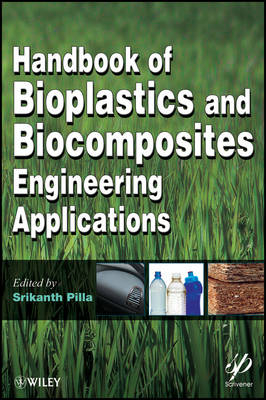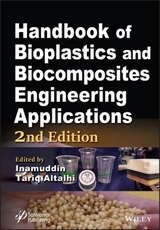
Handbook of Bioplastics and Biocomposites Engineering Applications
Wiley-Scrivener (Verlag)
978-0-470-62607-8 (ISBN)
- Titel erscheint in neuer Auflage
- Artikel merken
This Handbook is the first to explore the extensive applications made with bioplastics & biocomposites for the packaging, automotive, biomedical, and construction industries.
Bioplastics and biocomposites are becoming increasingly prominent because synthetic plastics and glass fiber composites are neither sustainable nor environmentally friendly.
The Handbook of Bioplastics and Biocomposites Engineering Applications brings together scientists from academia and industry to report on current research and applications in the bioplastics and biocomposites arena. This new science is interdisciplinary and integrates pure and applied sciences such as chemistry, engineering and materials science. The Handbook focuses on five main categories of applications: Packaging; Civil Engineering; Biomedical; Automotive; General Engineering.
The majority of the chapters review the properties, processing, characterization, synthesis and applications of the bio-based and biodegradable polymers and composites including:
Polymers such as polylactic acid (PLA), polyhydroxybutyrate (PHB), guar gum based plastics, cellulose polyesters, starch based bioplastics, vegetable oil derived bioplastics, biopolyethylene, chitosan, etc.
Thermoplastic and thermosetting bioplastics and biocomposites with a focus on the automobile industry.
The ways how to improve the properties of bioplastics, polymer blends, and biocomposites by combining them with both synthetic and natural fillers and reinforcements such as nanoclays, nanotubes (CNTs), and natural fibers (both wood and plant fibers).
Studies that expand the boundaries of bioplastics that will allow for the new materials to be applied to most generic engineering applications.
The Handbook will be of central interest to engineers, scientists and researchers who are working in the fields of bioplastics, biocomposites, biomaterials for biomedical engineering, biochemistry, and materials science. The book will also be of great importance to engineers in many industries including automotive, biomedical, construction, and food packaging.
Srikanth Pilla is a Research Manager in the BIONATES theme at the Wisconsin Institute for Discovery, University of Wisconsin-Madison. Prior to this, he was a Materials & Process Design Scientist at SuGanit Biorenewables LLC, Toledo, OH. Dr. Pilla received postdoctoral training from Stanford University and his PhD from University of Wisconsin-Milwaukee. He has published more than 50 technical papers, a textbook, and an edited volume. Additionally, he co-invented a home cleaning product (patent pending). He is a reviewer for more than 17 journals and currently serves on several SAE International technical committees. He has organized and chaired several conference sessions including SAE World Congress. Dr. Pilla currently serves as an Associate Editor for SAE International Journal of Materials and Manufacturing.
Foreword by Amar Mohanty. Part 1. Introduction.
Chapter 1. Bioplastics and Biocomposites and Their Applications: A Overview (Srikanth Pilla).
Part 2. Processing of Bioplastics and Biocomposites.
Chapter 2. The Handling of Various Forms of Dry Ingredients in Bioplastics Manufacturing and Processing Applications (Andy Kovats).
Chapter 3. Modeling the Processing of Natural Fiber Composites Made Using Liquid Composite Molding (Krishna M. Pillai).
Part 3. Engineering Applications of Bioplastics & Biocomposites.
Packaging Applications.
Chapter 4. Bioplastic Based Nanocomposites for Packaging Applications (Patricia Krawczak).
Chapter 5. Biobased Materials in Food Packaging Applications (Siddaramaiah).
Chapter 6. PLA Foams for Packaging Applications (Kate Parker).
Chapter 7. Polyvinyl Modified Guar-gum Bioplastics for Packaging Applications (Ashutosh Tiwari).
Chapter 8. Starch Based Composites for Packaging Applications (K. M. Gupta).
Chapter 9. Vegetable Oil-based Rigid Foam Composites (Chad Ulven).
Chapter 10. Sustainable Biocomposites Based for Construction Applications (Hazizan Akil).
Chapter 11. Starch as a Biopolymer in Construction and Civil Engineering (Chandan Datta).
Chapter 12. Cellulose Based Green Bioplastics for Biomedical Engineering (Ajay Mishra).
Chapter 13. Chitin and Chitosan Polymer Nanofibrous Membranes and Their Biological Applications (Ahsanulhaq Qurashi).
Automotive Applications.
Chapter 14. Microcellular Processed PHBV Foams for Automotive Applications (Alireza Javadi & Shaoqin Gong).
Chapter 15. Bioplastics and Vegetal Fibre Reinforced Bioplastics in Automotive Applications (Patricia Krawczak).
General Engineering Applications.
Chapter 16. Cellulose Nanofibers Reinforced Bioplastics and Their Applications (Susheel Kalia).
Chapter 17. Nanocomposites Based on Starch and Fibers of Natural Origin (Fernando Wypych).
Chapter 18. Biogenic Precursors for Polyphenol, Polyester and Polyurethane Resins (Harlin Ali).
Chapter 19. Long Biofibres & Engineered Pulps for High Performance Bioplastics & Biocomposites (Alan Fernyhough).
| Reihe/Serie | Wiley-Scrivener |
|---|---|
| Sprache | englisch |
| Maße | 185 x 262 mm |
| Gewicht | 1225 g |
| Themenwelt | Technik ► Umwelttechnik / Biotechnologie |
| ISBN-10 | 0-470-62607-0 / 0470626070 |
| ISBN-13 | 978-0-470-62607-8 / 9780470626078 |
| Zustand | Neuware |
| Informationen gemäß Produktsicherheitsverordnung (GPSR) | |
| Haben Sie eine Frage zum Produkt? |
aus dem Bereich



